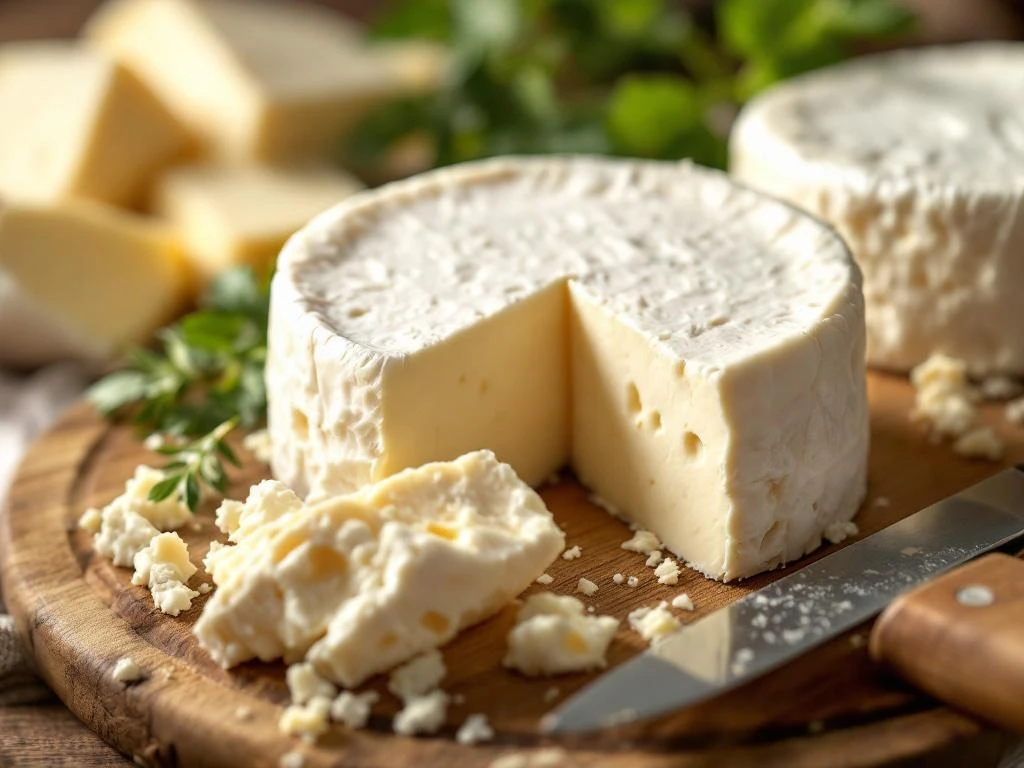The creamiest goat cheese variety is fresh chèvre, containing 60-80% moisture content and minimal aging. This soft, spreadable cheese maintains its signature smooth texture through careful production methods that preserve moisture and prevent protein breakdown. Fresh goat cheese varieties, including spreadable formats and whipped preparations, offer the creamiest textures ideal for B2B applications in retail, foodservice, and industrial processing.
Understanding creamy goat cheese textures
Creamy goat cheese textures result from a delicate balance of fat content, moisture levels, and specific production methods. The creaminess depends primarily on moisture retention, which typically ranges from 45% in semi-aged varieties to over 80% in fresh preparations. Production techniques, including controlled temperature processing and minimal handling, preserve the delicate protein structure that creates the characteristic smooth mouthfeel.
Fat content plays a crucial role, though goat cheese naturally contains less fat than many cow’s milk cheeses. Fresh goat cheese varieties often contain around 16% fat while maintaining exceptional creaminess through their high moisture content. The smaller fat globules in goat’s milk contribute to a naturally smoother texture compared to cow’s milk products.
Texture variations across goat cheese types range from ultra-smooth spreadable varieties to firmer aged options. Fresh varieties offer the creamiest textures, while ripened versions develop a denser consistency as moisture evaporates during the aging process. Understanding these variations helps B2B buyers select appropriate products for specific culinary applications.
What makes fresh chèvre the creamiest goat cheese?
Fresh chèvre achieves its supremely creamy texture through minimal processing and immediate packaging after production. The cheese undergoes no aging, preserving its remarkable 60-80% moisture content. This high moisture level, combined with the natural properties of goat’s milk proteins, creates an exceptionally smooth, spreadable consistency that surpasses other cheese varieties.
Production methods for maintaining creaminess include gentle pasteurisation, controlled acidification, and careful draining processes. These techniques preserve the delicate protein matrix while preventing excessive moisture loss. Fresh chèvre production often incorporates specific starter cultures that enhance the creamy texture whilst developing the characteristic tangy flavour profile.
Storage conditions critically impact texture preservation. Fresh chèvre requires consistent refrigeration between 2-4°C and should remain in airtight packaging to prevent moisture loss. For foodservice applications, proper storage extends the creamy texture for up to three weeks, making it ideal for high-turnover operations requiring consistent quality.
How does aging affect goat cheese creaminess?
Aging transforms goat cheese texture through controlled moisture evaporation and protein development. Fresh goat cheese begins with maximum creaminess, gradually developing firmer textures as aging progresses. During the first week of aging, moisture content decreases by approximately 10-15%, creating a denser yet still creamy consistency ideal for slicing applications.
Semi-aged goat cheeses, matured for 2-4 weeks, develop a dual texture profile. The interior remains creamy whilst the exterior forms a delicate rind that helps preserve moisture. This aging process creates versatile products suitable for both spreading and melting applications, particularly valuable for foodservice operations requiring multi-functional ingredients.
Rind formation during aging serves as a natural barrier, protecting the creamy interior from excessive moisture loss. Ripened goat cheese rolls exemplify this principle, maintaining a soft, creamy core beneath their developed exterior. Temperature and humidity control during aging determines the final texture, with higher humidity levels preserving more creaminess throughout the maturation process.
Which goat cheese varieties offer the smoothest texture for culinary applications?
Fresh goat cheese logs provide the smoothest texture for spreading applications, making them ideal for sandwich preparations and cold culinary uses. These varieties maintain consistent creaminess throughout, offering predictable performance in high-volume foodservice environments. Their uniform texture ensures easy portioning and application across various menu items.
Whipped goat cheese preparations deliver ultra-smooth textures perfect for dips, sauces, and garnishes. These products undergo additional processing to incorporate air, creating lighter consistencies that blend seamlessly with other ingredients. Goat cheese crumbles offer versatility, melting smoothly when heated whilst maintaining distinct texture in cold applications.
For melting applications, semi-soft goat cheese varieties provide optimal results. Products like goat cheese pucks offer pre-portioned convenience whilst delivering smooth melting characteristics on pizzas, in gratins, and other hot preparations. These formats address specific foodservice needs, combining texture performance with operational efficiency.
What’s the difference between creamy goat cheese and cream cheese?
Goat cheese achieves its creamy texture through naturally smaller fat globules and unique protein structures, whilst cream cheese relies on higher fat content and specific processing methods. Fresh goat cheese typically contains 16-20% fat compared to cream cheese’s 33% minimum, yet maintains comparable or superior spreadability due to its moisture content and protein composition.
Texture differences manifest in mouthfeel and application versatility. Goat cheese offers a lighter, more delicate creaminess with a characteristic tang, whilst cream cheese provides denser, richer textures. The smaller fat particles in goat’s milk create naturally smoother textures without requiring the extensive homogenisation processes used in cream cheese production.
Nutritional profiles differ significantly, with goat cheese offering easier digestibility due to its protein structure and lower lactose content. The lighter texture of goat cheese makes it particularly suitable for applications requiring delicate flavours and smooth incorporation into dishes, whilst cream cheese excels in applications demanding richness and density.
Key takeaways for selecting the creamiest goat cheese
Selecting the creamiest goat cheese requires understanding moisture content, intended applications, and storage capabilities. Fresh varieties with 60-80% moisture deliver maximum creaminess for spreading and cold preparations. Semi-aged options balance creaminess with versatility for both hot and cold applications. Consider packaging formats that match your operation’s volume requirements, from 100g retail portions to 10kg industrial packs.
Storage and handling practices directly impact texture maintenance. Implement proper cold chain management, maintaining consistent refrigeration and minimising temperature fluctuations. For operations requiring extended shelf life whilst preserving creaminess, consider products with protective packaging or natural rind development.
Our Alphenaer range encompasses the full spectrum of creamy goat cheese specialities, from ultra-smooth spreads to versatile ripened varieties. Each product maintains the traditional quality and craftsmanship essential for demanding B2B applications, backed by IFS certification ensuring consistent quality and reliable supply for retail, foodservice, and industrial partners worldwide.
